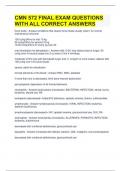CMN 572 FINAL EXAM QUESTIONS
WITH ALL CORRECT ANSWERS
force fluids - Answer-conditions that require force fluids usually need 1.5x normal
maintenance amounts
100 cc/kg/24hrs for first 10 kg
50 cc/kg/24hrs for second 10 kg
10-25 cc/kg/24hrs for every kg over 20
oral rehydration for dehydration - Answer-mild: 3-5% loss without loss of turgor; 50
cc/kg over 4 hrs plus losses (try 3 cc every 5 min if vomiting)
moderate: 6-9% loss with decreased turgor and <1 cc/kg/hr of urine output; replace with
100 cc/kg over 4 hrs plus losses
severe: admit for rehydration
formed elements of the blood - Answer-RBC, WBC, platelets
if more than one is decreased, think bone marrow dysfunction
pancytopenia: depression of all formed elements
neutrophils - Answer-leukocytosis (increased)= BACTERIAL INFECTION, stress, burns,
leukemia, steroid use, RA
leukopenia (decreased)= folate/B12 deficiency, aplastic anemia, chemo, sulfonamides
lymphocytes - Answer-lymphocytosis (increased)= VIRAL INFECTION, leukemia,
adrenal insufficiency
lymphocytopenia (decreased)= HIV, aplastic anemia, glucocorticoid use, SLE, RA
eosinophils - Answer-eosinophilia (increased)= ALLERGIES, PARASITIC INFECTION,
leukemia, autoimmune
decreased with nutritional deficiencies, glucocorticoid use
basophils - Answer-increased with allergic reaction, CML, hodgkins, oral contraceptives
decreased with nutritional deficiencies, glucocorticoid use
,monocytes - Answer-increased with CHRONIC INFLAMMATION, stress, cushings, viral
infection, sarcoidosis
decreased with aplastic anemia, AML, glucocorticoid, myelotoxic drugs
platelets - Answer-thrombocytes
aid in coagulation
thrombocytosis (increased)= acute blood loss, CML, iron deficiency, polycythemia vera,
hypospleenism
thrombocytopenia (decreased)= ITP, HELLP, hemplytic/uremic syndrome
bands - Answer-immature neutrophils
shift to left means increased bands and acute infection (sometimes pernicious anemia
or leukemia)
iron deficiency - Answer-universal screening at 1 yr
if mild anemia is present, provide iron supplements and repeat hgb in 1-3 months
all infants with anemia should have serum feritin and CRP measured
children with severe anemia, family hx of hematologic illness or infants with f/u hgb <10
should be further eval'd with venous blood draw
management of irone deficiency is iron supplements and education
lead poisoning - Answer-risk screening should be done at 1 yr
also indicated in children with persistent anemia, live in house built before 1977, or have
developmental delay
lead poisoning= plubism
many children have levels high enough to cause neuro/intellectual delay; they are also
at risk for kidney damage, encephalopathy, and seizures
all characteristics of ADD can be caused by low dose exposure to lead
sx: acute crampy abdominal pain, vomiting, constipation, anorexia, HA, decreased
developement, lethargy
, major sources: lead based paint #1, lead solder, lead pipes, occupations/hobbies that
involve lead, some cosmetics and pottery, imported cans
diets deficient in iron and calcium and high in fat increase risk for lead poisoning
because it allows lead to be more quickly and readily absorbed; IRON DEFICIENCY IS
GREATEST DIETARY RISK FACTOR
90% of lead is stored in bones and teeth where it is inert; it is exreted by kidneys, GI,
and through sweat; 90% of lead in the blood attaches to RBC
tx: remove source, improve nutrition, chelation therapy IM
iron deficiency anemia - Answer-microcytic, hypochromic
due to insufficient intake of iron or excessive blood loss
most common cause in women: menstrual blood loss
most common cause in men: GI blood loss
most common cause in childre: insufficient intake/intestinal hookworms
adolescent growth spurt can result in iron def. anemia
tx: oral feSo4 6 mg/kg/day in 3 div. doses; adults= 300 mg/day; continue therapy for 3-6
months after H&H returns to normal to rebuild iron stores
milk, antacids, and tea interfere with iron absorption; vit C and citrus acid aid absorption
liquid iron stains teeth- use straw
iron def. anemia is most common anemia during pregnancy- all pregnant women should
take supplements to PREVENT, it increases risk for pre-eclampsia, eclampsia, and
postpartal hemorrhage; may delay healing of episiotomy; newborn may be low birth
weight and hypoxic at birth
chlamydia - Answer-gold standard of testing is CX
NAAT can be used to also test for gonorrhea
treatment: azithromycin 1 g PO once (doxy if PCN allergy); azithromycin is OK with
pregnancy
gonorrhea - Answer-NAAT, cx, or gram stain for testing
treatment: 250 mg ceftriaxone IM once PLUS azithromycin 1 g PO once
gonorrhea and chlamydia often occur together




